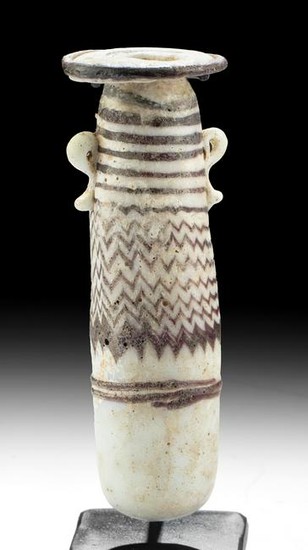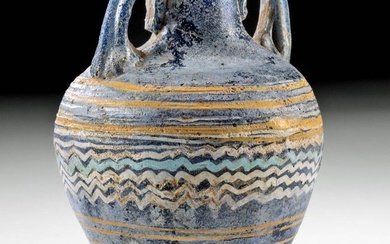Greek Core-Form Glass Alabastron, White / Aubergine
Ancient Greece, Classical Period, ca. late 6th to early 5th century BCE. A striking core-formed glass alabastron, so named because many vessels that assumed this form were made of alabaster. The vessel presents a characteristically elongated body with a rounded bottom, a discoid rim ringed with dark glass, and trailed handles gracing the shoulders. Its bi-chrome color scheme and decorative patterns are simply magnificent. The alabastron is composed of opaque white glass with aubergine trailing that was combed into a feathered or herringbone pattern along the midsection. Horizontal amethyst-hued bands rise above this zigzagged section and underscore it below. In addition, areas of silver and rainbow-hued iridescence are visible across the composition and imbue it with an opulent appearance. A fabulous work of glass art replete with sophisticated technique, beautiful hues, and elegant artistry! Size: 1.375" W x 3.9" H (3.5 cm x 9.9 cm); 4.3" H (10.9 cm) on included custom stand.
According to the Corning Museum of Glass, core forming is "the technique of forming a vessel by winding or gathering molten glass around a core supported by a rod. After forming, the object is removed from the rod and annealed. After annealing, the core is removed by scraping." This process of glass making was begun in the late 16th century BCE by glassmakers of Mesopotamia, and then adopted by Egyptian glassmakers in the 15th century BCE. The technique almost came to an end in the so-called Dark Ages of Mediterranean civilization (1200 to 900 BCE); however, by the 9th century BCE a new generation of glassmakers took up the technique once again, and between the 6th and 4th century BCE core-forming spread throughout the Mediterranean.
The alabastron is a long-bodied vessel with a rounded bottom, a tapered or cylindrical neck, and a flared, flattened mouth. According to the Beazley Archive of the University of Oxford, the alabastron shape's history extends back to Corinth, but was only preserved in Athenian pottery examples back to the mid-sixth century BCE. Alabastra were created in many materials, including alabaster, and the Greek term for this stone - alabastron (most likely of Egyptian origin) - was the source of inspiration for the name of this shaped vessel. Many examples were finished with a white ground, as if to imitate this stone. We know from vase painting imagery of women using alabastra following a bath, that these vessels most likely held perfumed oils.
For a stylistically similar example, please see The Metropolitan Museum of Art, accession number 81.10.313.
Another stylistically similar example hammered for $5,376 at Christie's, New York "Antiquities" auction (sale 1163, December 12, 2002, lot 362).
Provenance: private East Coast, USA collection; ex-Artemis Gallery; ex-private New Jersey, USA collection; ex-Martin Wunsch collection, New York, USA, acquired in the 1980s
All items legal to buy/sell under U.S. Statute covering cultural patrimony Code 2600, CHAPTER 14, and are guaranteed to be as described or your money back.
A Certificate of Authenticity will accompany all winning bids.
We ship worldwide to most countries and handle all shipping in-house for your convenience.
#152730 Dimensions: Condition Report: Repaired from multiple large pieces with light adhesive residue along break lines, and areas of restoration and overpainting. Minor abrasions to rim and body, with a few stable hairline fissures, and light encrustations. Nice earthen deposits and great iridescence throughout.
View it on
Estimate
Time, Location
Auction House
Ancient Greece, Classical Period, ca. late 6th to early 5th century BCE. A striking core-formed glass alabastron, so named because many vessels that assumed this form were made of alabaster. The vessel presents a characteristically elongated body with a rounded bottom, a discoid rim ringed with dark glass, and trailed handles gracing the shoulders. Its bi-chrome color scheme and decorative patterns are simply magnificent. The alabastron is composed of opaque white glass with aubergine trailing that was combed into a feathered or herringbone pattern along the midsection. Horizontal amethyst-hued bands rise above this zigzagged section and underscore it below. In addition, areas of silver and rainbow-hued iridescence are visible across the composition and imbue it with an opulent appearance. A fabulous work of glass art replete with sophisticated technique, beautiful hues, and elegant artistry! Size: 1.375" W x 3.9" H (3.5 cm x 9.9 cm); 4.3" H (10.9 cm) on included custom stand.
According to the Corning Museum of Glass, core forming is "the technique of forming a vessel by winding or gathering molten glass around a core supported by a rod. After forming, the object is removed from the rod and annealed. After annealing, the core is removed by scraping." This process of glass making was begun in the late 16th century BCE by glassmakers of Mesopotamia, and then adopted by Egyptian glassmakers in the 15th century BCE. The technique almost came to an end in the so-called Dark Ages of Mediterranean civilization (1200 to 900 BCE); however, by the 9th century BCE a new generation of glassmakers took up the technique once again, and between the 6th and 4th century BCE core-forming spread throughout the Mediterranean.
The alabastron is a long-bodied vessel with a rounded bottom, a tapered or cylindrical neck, and a flared, flattened mouth. According to the Beazley Archive of the University of Oxford, the alabastron shape's history extends back to Corinth, but was only preserved in Athenian pottery examples back to the mid-sixth century BCE. Alabastra were created in many materials, including alabaster, and the Greek term for this stone - alabastron (most likely of Egyptian origin) - was the source of inspiration for the name of this shaped vessel. Many examples were finished with a white ground, as if to imitate this stone. We know from vase painting imagery of women using alabastra following a bath, that these vessels most likely held perfumed oils.
For a stylistically similar example, please see The Metropolitan Museum of Art, accession number 81.10.313.
Another stylistically similar example hammered for $5,376 at Christie's, New York "Antiquities" auction (sale 1163, December 12, 2002, lot 362).
Provenance: private East Coast, USA collection; ex-Artemis Gallery; ex-private New Jersey, USA collection; ex-Martin Wunsch collection, New York, USA, acquired in the 1980s
All items legal to buy/sell under U.S. Statute covering cultural patrimony Code 2600, CHAPTER 14, and are guaranteed to be as described or your money back.
A Certificate of Authenticity will accompany all winning bids.
We ship worldwide to most countries and handle all shipping in-house for your convenience.
#152730 Dimensions: Condition Report: Repaired from multiple large pieces with light adhesive residue along break lines, and areas of restoration and overpainting. Minor abrasions to rim and body, with a few stable hairline fissures, and light encrustations. Nice earthen deposits and great iridescence throughout.




